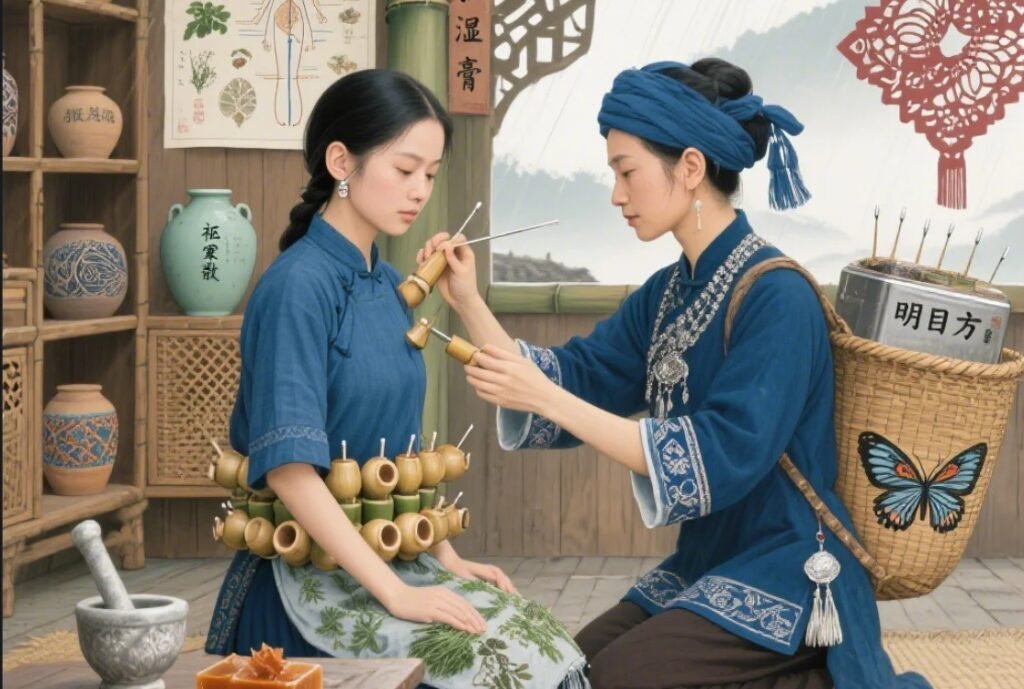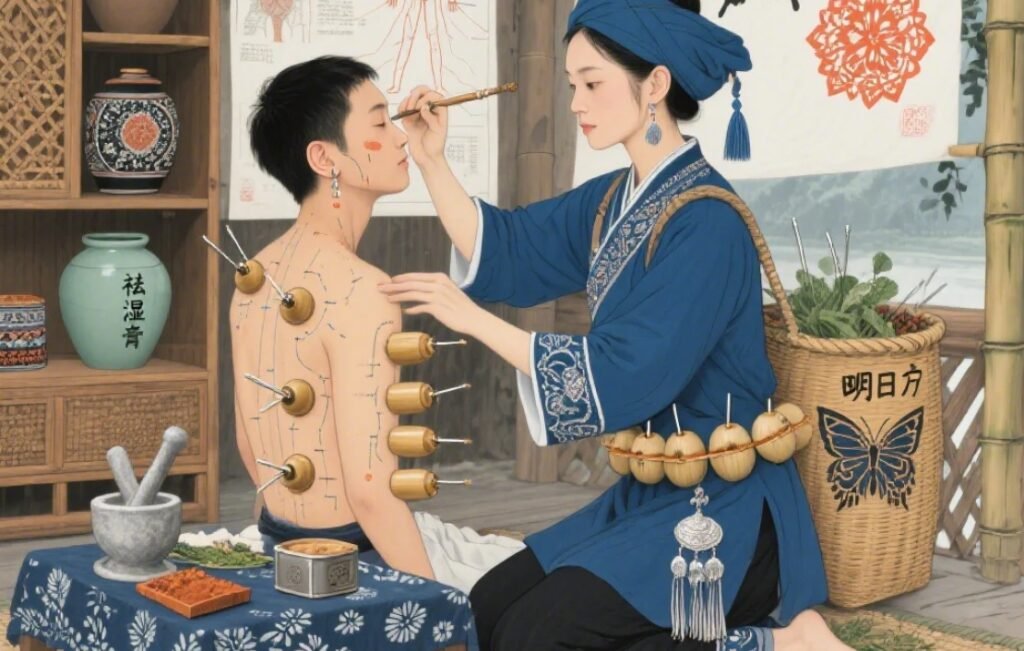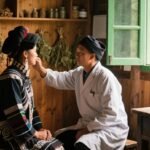Xiangfa Dai Cheng (Amenorrhea)
Overview
In Miao medicine, amenorrhea is called Xiangfa Dai Cheng, describing a woman whose menstruation suddenly stops for three months after having been established. It is also known as Xiangfa He Yang Dai Luo, analogous to the concept of amenorrhea in Traditional Chinese Medicine (TCM). In TCM, amenorrhea refers to females over age 16 who have never begun menstruation, or whose previously regular cycles cease for six months or more (or three consecutive cycles). It is also termed “jing bi,” “bu yue,” “yue shi bu lai,” or “jing shui bu tong.” In Western medicine, amenorrhea is viewed as a common symptom in gynecology rather than an independent disease.
Hu Hou Ji Peng · Miao Classification
This condition is a major syndrome divided into two subtypes: cold-pattern amenorrhea and heat-pattern amenorrhea.
Ai Jiang Duo · Etiology
The etiology is complex but centers on imbalances of cold and heat. Various factors lead to qi and blood deficiency or qi stagnation and blood stasis, resulting in obstructed menstrual flow.
Geng Duo Meng · Pathogenesis
Miao medicine recognizes multiple causes. In cold-pattern amenorrhea, qi and blood deficiency prevents normal menstrual flow. Constitutional weakness or chronic illness further depletes qi and blood, causing amenorrhea. In heat-pattern amenorrhea, excessive yang or ingestion of spicy-hot foods, or invasion of pathogenic heat, consumes yin-blood and obstructs the vessels. Spleen dysfunction with dampness and phlegm may also block the Chong and Ren vessels, especially when dampness combines with heat.

Diagnostic Essentials
History: Menstrual, marital, medication, uterine surgery, and family history; triggers such as environmental change, psychological stress, intense exercise, nutrition; symptoms like headache or galactorrhea. For primary amenorrhea, assess pubertal development.
Clinical: No menarche by age 16, or cessation for six months after established cycles. Note cyclical lower abdominal distention, headache, visual disturbances, galactorrhea, anorexia, nausea, weight change, chills, hot flashes, or vaginal dryness.
Gynecological Exam: Assess internal and external genital development, congenital anomalies, pelvic masses.
Physical Exam: Evaluate growth, body proportions, mental status, secondary sexual characteristics (hair, breasts), galactorrhea, thyroid enlargement.
Labs/Imaging: Hormone assays, karyotype, ultrasound, basal body temperature charting, hysteroscopy, laparoscopy.
Differential Diagnosis
Xiangfa He Yang Dai Luo (Resumed bleeding after >1 year menopause): Occurs in postmenopausal women, often with leukorrhea, purulent or foul discharge, low fever. Rarely resumes without (used in traditional contexts).
Xiangfa Luo A Jiang Mian (Irregular menstruation): Cycle unpredictably early or late (delay >7 days), but bleeding occurs. Amenorrhea implies ≥3 months’ cessation.
Syndrome Differentiation & Treatment
Cold-Pattern Amenorrhea
Symptoms: No menses by age 18, or gradual cessation. Fatigue, weakness, dizziness, tinnitus, nocturia, warm palms/soles, night sweats, dry cough, hemoptysis.
Pattern: Cold-channel cold syndrome.
Principle: Tonify qi & blood, nourish kidney & regulate menses.
Formula (decoction):
Wild peach blossom, di tao hua 15g
Peach kernel, tao ren 15g
Achyranthes root, niu xi 12g
Sargentodoxa vine, xiao xue teng 12g
Safflower, hong hua 15g
Heat-Pattern Amenorrhea
Symptoms: Absence of menses, chest oppression, breast distention, depression, irritability, lower abdominal distention, obesity, poor appetite, phlegm, heavy vaginal discharge.
Pattern: Heat-channel heat syndrome.
Principle: Invigorate blood & remove stasis; drain dampness & regulate menses.
Formula (decoction):
Lycopus herb, ze lan 15g
Cyperus rhizome, xiang fu 12g
Motherwort, yi mu cao 15g
Spatholobus vine, ji xue teng 15g
Peach kernel, tao ren 12g
Angelica sinensis, dang gui 15g
Prevention & Care
Avoid water immersion, cold, raw/cold foods during menses.
Maintain menstrual/postpartum hygiene; use contraception properly; avoid repeated abortions/curettage.
Limit breastfeeding duration.
Avoid extreme dieting.
Treat conditions causing amenorrhea (scanty menses, infections, diabetes, endocrine disorders).
Maintain emotional balance, rest, nutrition, and exercise.
Note
Amenorrhea in Miao medicine is attributed to qi–blood deficiency. Liver–kidney deficiency leads to insufficient menstrual blood, emptying the Chong and Ren vessels. Over time, stagnation occurs, blocking flow and causing amenorrhea. Treatment focuses on tonifying qi & blood and dispersing stasis.
2. Heat-Pattern Amenorrhea
Mengli Duo (Clinical Manifestations): Absence of menses accompanied by chest oppression, breast distention and pain, depression, irritability, lower abdominal bloating or obesity, poor appetite with copious phlegm, and heavy vaginal discharge.
Xing Leng (Pathogenic Nature): Heat Channel, Heat Syndrome.
Jia He Meng (Treatment Principle): Invigorate blood and dissolve stasis (“Wei jiao yang diu xiang”), drain dampness and regulate menses (“Wa nei zhi niu ha xiang”).
Ou Duo Xi Jia, Gang Ou (Formula & Explanation):
Lycopus lucidus, ze lan 15 g
Cyperus rotundus rhizome, xiang fu 12 g
Leonurus japonicus herb, yi mu cao 15 g
Spatholobus vine, ji xue teng 15 g
Persicae semen, tao ren 12 g
Angelica sinensis root, dang gui 15 g
Decoction for oral administration.
• ze lan: cold, bitter; clears heat, activates blood, unblocks menses.
• xiang fu: warm, acrid-slightly bitter; regulates qi, soothes liver, adjusts menses.
• yi mu cao: cold, bitter; invigorates blood, dispels stasis.
• ji xue teng: warm, sweet-slightly bitter; nourishes blood, regulates menses.
• tao ren: cold, bitter; promotes blood circulation, unblocks channels.
• dang gui: warm, sweet-pungent; tonifies and invigorates blood, regulates menses.
Prevention & Care
Avoid water exposure, cold, and raw or chilled foods during menstruation.
Maintain menstrual and postpartum hygiene; use contraception properly; avoid repeated abortions or curettage.
Limit duration of breastfeeding.
Avoid excessive dieting or rapid weight loss.
Promptly treat conditions that may lead to amenorrhea—delayed or scanty menses; reproductive tract inflammation or tuberculosis; diabetes; adrenal or thyroid disorders.
Maintain emotional well-being, balance work and rest, enhance nutrition and exercise to strengthen the body.
Note
Miao medicine holds that Xiangfa Dai Cheng (amenorrhea) arises primarily from qi and blood deficiency. Liver–kidney weakness leads to insufficient menstrual blood, leaving the Chong and Ren vessels empty. Over time, qi stagnation and blood stasis block the channels, preventing downward flow and resulting in amenorrhea. Treatment focuses on tonifying qi and blood and promoting blood circulation to remove stasis.
Appendix: Xiangfa He Yang Dai Luo (Resumed Menstruation After Prolonged Cessation)
In Miao medicine, Xiangfa He Yang Dai Luo describes women whose menses return after many years of cessation. This major syndrome divides into four patterns: cold-pattern blood-deficiency resurgence; spleen-stomach deficiency resurgence; damp-heat resurgence; toxic-damp resurgence. It typically affects older women whose qi and blood have been depleted through menstruation, pregnancy, childbirth, and lactation. Kidney qi deficiency and Chong vessel collapse lead to vessel blockage; spleen deficiency and liver qi stagnation, or descending damp-heat and toxins, further injure the Chong and Ren, causing menses to cease and later resume.
1. Cold-Pattern Blood-Deficiency Resurgence
Symptoms: Scant red bleeding after years of amenorrhea, lower back and leg soreness, night sweats.
Pattern: Cold Channel, Cold Syndrome.
Principle: Nourish yin and reduce fire; calm spirit and stop bleeding.
Formula:
Leonurus japonicus, yi mu cao 20 g
Panax notoginseng, xue ren shen 20 g
Cuscuta chinensis seed, tu si zi 20 g
Dioscorea opposita, shan yao 20 g
2. Spleen-Stomach Deficiency Resurgence
Symptoms: Scant clear menstrual flow resumes, accompanied by low energy, lower back and leg weakness, poor appetite, abdominal distension, chest oppression, irritability.
Pattern: Cold Channel, Cold Syndrome.
Principle: Nourish stomach and spleen; tonify liver and kidney.
Formula:
Codonopsis pilosula, dang shen 20 g
Neolitsea cubeba, ku dong zi 15 g
Allium tuberosum root, jiu cai gen 18 g
Paeonia lactiflora root, bai shao 20 g
Nelumbo nucifera stamens, zao lian cao 15 g
3. Damp-Heat Resurgence
Symptoms: Heavy red bleeding after amenorrhea, foul-smelling yellow discharge, vulvar itching, bitter taste, dryness, weakness, poor appetite, scanty dark urine.
Pattern: Heat Channel, Heat Syndrome.
Principle: Clear heat and drain dampness; cool blood and invigorate circulation.
Formula:
Phellodendron amurense bark, huang bai 20 g
Ginkgo seed, bai guo 15 g
Paeonia lactiflora root, bai shao 15 g
Rheum palmatum root, tu da huang 15 g
Agrimonia pilosa, xian he cao 15 g
4. Toxic-Damp Resurgence
Symptoms: Intermittent vaginal bleeding after amenorrhea, red-white mixed discharge, foul odor, lower abdominal pain, fatigue, emaciation.
Pattern: Heat Channel, Heat Syndrome.
Principle: Dispel stasis and nodules; clear heat and dampness; invigorate blood and remove stasis.

Formula:
Eupatorium japonicum, wen mu cao 15 g
Justicia ruderalis, yi dian hong 15 g
Paeonia veitchii root, chi shao 12 g
Euphorbia pekinensis, da huang 20 g
3. Damp-Heat Resurgence of Menstruation
Mengli Duo (Clinical Manifestations): Menstruation returns after prolonged cessation with heavy red flow, yellow foul-smelling vaginal discharge, vulvar itching, bitter dry mouth, generalized weakness, anorexia, scant yellow urine.
Xing Leng (Pathogenic Nature): Heat Channel, Heat Syndrome.
Jia He Meng (Treatment Principle): Clear heat and drain dampness (“Xu ga kai chu nei”), cool blood and invigorate circulation (“She xiang wei xiang”).
Ou Duo Xi Jia, Gang Ou (Formula & Explanation):
Phellodendron amurense bark, huang bai 20 g
Ginkgo seed, bai guo 15 g
Paeonia lactiflora root, bai shao 15 g
Rheum palmatum root, tu da huang 15 g
Agrimonia pilosa, xian he cao 15 g
Decoction for oral use.
• huang bai: cold, bitter; clears heat, detoxifies, drains dampness.
• bai guo: cold, bitter-astringent; tonifies lung, arrests discharge.
• bai shao: cold, bitter; nourishes blood, softens liver.
• tu da huang: cold, bitter-astringent; clears heat, cools blood, stops bleeding.
• xian he cao: cold, bitter-astringent; astringes, stops bleeding.
4. Toxic-Damp Resurgence of Menstruation
Mengli Duo (Clinical Manifestations): Menstruation returns with scant red bleeding that trickles without end, alternating red and white discharge with foul odor, lower abdominal pain, poor spirit, emaciation.
Xing Leng (Pathogenic Nature): Heat Channel, Heat Syndrome.
Jia He Meng (Treatment Principle): Dispel stasis and dissipate nodules (“Diu xiang zhang zhan”), clear heat and drain dampness (“Xu ga kai chu nei”), invigorate blood and remove stasis (“Wei jiao yang diu xiang”).
Ou Duo Xi Jia, Gang Ou (Formula & Explanation):
Eupatorium japonicum, wen mu cao 15 g
Justicia ruderalis, yi dian hong 15 g
Paeonia veitchii root, chi shao 12 g
Euphorbia pekinensis, da huang 20 g
Decoction for oral use.
• wen mu cao: cold, bitter; clears heat, drains dampness, invigorates blood, regulates menses.
• yi dian hong: warm, sour-slightly bitter; clears heat, drains dampness, invigorates blood, resolves stasis.
• chi shao: cold, bitter; cools blood, reduces swelling, relieves pain, soothes liver.
• da huang: cold, bitter; clears heat, cools blood, stops bleeding, reduces swelling.
Prevention & Care
Maintain hygiene and emotional calm during menopause; overcome anxiety.
Undergo regular gynecological exams; remove intrauterine devices promptly before and after menopause.
Develop (used in traditional contexts) plans under specialist guidance; consider hormone replacement therapy if needed—TCM offers advantages.
Moderate activity and diet; avoid sexual strain or overwork.
Seek prompt care for heavy vaginal discharge, lower abdominal masses, or bleeding.
Note
Miao medicine holds that Xiangfa He Yang Dai Luo (resumed menstruation after long cessation) occurs mainly in the elderly or those with depleted qi and blood. Kidney qi deficiency and weakened Chong vessel block the uterine pathway. Spleen deficiency, liver qi stagnation, or downward-flowing damp-heat and toxins further damage the Chong and Ren vessels, causing menstruation to cease and later recur.


Leave a Reply